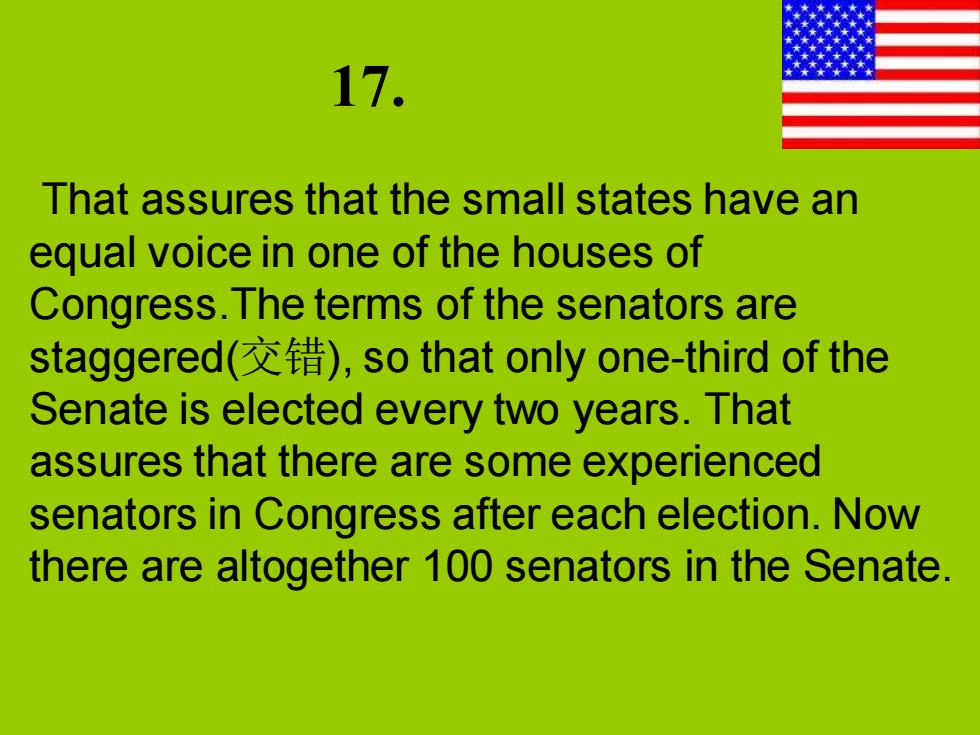
13.The Political System in USA USA is a republic with a federal system.There are now 50 states altogether,with 48 states on mainland America and 2 states outside mainland America(the Hawaii State is in the Pacific Ocean and the Alaska State is in the northwest corner of North America,which is separated by Canada). The Federal Government is composed of three branches:
13.The Political System in USA USA is a republic with a federal system. There are now 50 states altogether, with 48 states on mainland America and 2 states outside mainland America(the Hawaii State is in the Pacific Ocean and the Alaska State is in the northwest corner of North America, which is separated by Canada). The Federal Government is composed of three branches:

14. )The Legislative(立法)—Congress(国会), 2) The Executive(行政)一the White House;the Office of the President((白宫,即总统府); 3)The Judicial(司法)一the Supreme Court(最高法院) Each branch has powers that the others do not have and each branch has a way of counteracting and limiting any wrongful action by another branch. 三权分立,相互制衡
14. 1) The Legislative(立法)—Congress(国会); 2) The Executive(行政)—the White House; the Office of the President(白宫,即总统府); 3) The Judicial(司法)—the Supreme Court(最高法院). Each branch has powers that the others do not have and each branch has a way of counteracting and limiting any wrongful action by another branch. 三权分立,相互制衡

15.Legislative Branch The legislative branch is made up of elected representatives from all of the states and is the only branch that can make federal laws,levy federal taxes,declare war or put foreign treaties into effect.It consists of a Congress that is divided into two houses: The House of Representatives(众议 )comprises lawmakers who serve two-year terms.Each House member(众议员)represents
15.Legislative Branch The legislative branch is made up of elected representatives from all of the states and is the only branch that can make federal laws, levy federal taxes, declare war or put foreign treaties into effect. It consists of a Congress that is divided into two houses: The House of Representatives(众议 院)comprises lawmakers who serve two-year terms. Each House member(众议员)represents

16. a district in his or her home state.The number of districts in a state is determined by a count of the population taken every 10 years.In the 1980s,there were 435 representatives in the House of Representatives. The Senate(参议院)comprises lawmakers who serve six-year terms.Each state,regardless of population,has two senators(参议员)
16. a district in his or her home state. The number of districts in a state is determined by a count of the population taken every 10 years. In the 1980s, there were 435 representatives in the House of Representatives. The Senate(参议院)comprises lawmakers who serve six-year terms. Each state, regardless of population, has two senators(参议员)

17. That assures that the small states have an equal voice in one of the houses of Congress.The terms of the senators are staggered(交错),so that only one-third of the Senate is elected every two years.That assures that there are some experienced senators in Congress after each election.Now there are altogether 100 senators in the Senate
17. That assures that the small states have an equal voice in one of the houses of Congress.The terms of the senators are staggered(交错), so that only one-third of the Senate is elected every two years. That assures that there are some experienced senators in Congress after each election. Now there are altogether 100 senators in the Senate

18. The main duty of the Congress is to make laws, including those which levy taxes that pay for the work of the federal government.A law begins as a proposal called a“bill"(提案).It is read, studied in committes,commented on and amended in the Senate or house chamber in which it was introduced.It is then voted upon.If it passes,it is sent to the other house where
18. The main duty of the Congress is to make laws, including those which levy taxes that pay for the work of the federal government. A law begins as a proposal called a “bill”(提案). It is read, studied in committes, commented on and amended in the Senate or house chamber in which it was introduced. It is then voted upon. If it passes, it is sent to the other house where